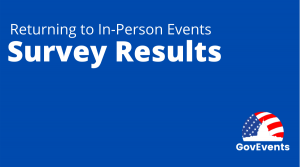 This May, after the CDC updated their public health guidance around masking and social distancing for vaccinated individuals, GovEvents surveyed its members to find out what government professionals were comfortable with in terms of in-person events. Feedback from event planners at the beginning of 2021 showed they were beginning to plan toward a hybrid event schedule, looking to introduce in-person events in the late summer or fall. Now that schedule seems to be a reality based both on health guidance and attendee attitudes.
This May, after the CDC updated their public health guidance around masking and social distancing for vaccinated individuals, GovEvents surveyed its members to find out what government professionals were comfortable with in terms of in-person events. Feedback from event planners at the beginning of 2021 showed they were beginning to plan toward a hybrid event schedule, looking to introduce in-person events in the late summer or fall. Now that schedule seems to be a reality based both on health guidance and attendee attitudes.
The GovEvents survey of 275+ public sector professionals found that nearly 75% of respondents would be comfortable attending an event in-person sometime in 2021.


 As we emerge from the isolation of the pandemic and begin interacting in person again, it will be in a world that looks and feels a lot different. While we crave human interaction, that does not mean we want to go back to standing in lines at office buildings to complete certain tasks. Over the past year, people have gotten used to doing things virtually. Government agencies have made incredible progress moving traditionally manual, paper-intensive, in-person processes online, and there's no reason that should stop now that in-person is an option.
As we emerge from the isolation of the pandemic and begin interacting in person again, it will be in a world that looks and feels a lot different. While we crave human interaction, that does not mean we want to go back to standing in lines at office buildings to complete certain tasks. Over the past year, people have gotten used to doing things virtually. Government agencies have made incredible progress moving traditionally manual, paper-intensive, in-person processes online, and there's no reason that should stop now that in-person is an option. Artificial Intelligence is being implemented across government to modernize and automate traditional manual processes. For many organizations, this means taking paper-based, tedious, error-prone tasks and turning them over to a machine for automated completion. Beyond using AI to hand off tasks best completed by machines -- those that are rote and repetitive -- agencies are also looking at ways to introduce the technology into already complex human-driven activities to make them even more effective and efficient.
Artificial Intelligence is being implemented across government to modernize and automate traditional manual processes. For many organizations, this means taking paper-based, tedious, error-prone tasks and turning them over to a machine for automated completion. Beyond using AI to hand off tasks best completed by machines -- those that are rote and repetitive -- agencies are also looking at ways to introduce the technology into already complex human-driven activities to make them even more effective and efficient. The last year has brought about incredible change in the federal workforce, and it shows no sign of stopping. With a new Director for the Office of Personnel and Management (OPM)
The last year has brought about incredible change in the federal workforce, and it shows no sign of stopping. With a new Director for the Office of Personnel and Management (OPM)  President Biden's $2 trillion
President Biden's $2 trillion 
